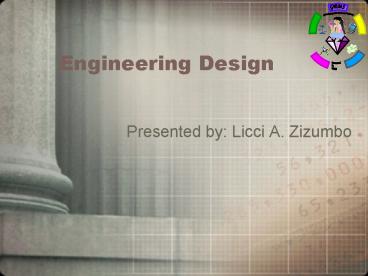Engineering Design PowerPoint PPT Presentation
1 / 25
Title: Engineering Design
1
Engineering Design
- Presented by Licci A. Zizumbo
2
Agenda
- Bridge Basics
- Forces Lab
- Who Builds BIG?
- Wonders of the World
- Bridge Challenge
- Computer Model
- Balsa Wood Model
3
1, 2, 3s and A, B, Cs of Bridge Basics
- There are more than half a million bridges in the
United States, and you rely on them every day to
cross obstacles like streams, valleys, and
railroad tracks. But do you know how they work?
Or why some bridges are curved while others are
straight? - Engineers must consider many things -- like the
distance to be spanned and the types of materials
available -- before determining the size, shape,
and overall look of a bridge. - Since ancient times, engineers have designed
three major types of bridges to withstand all
forces of nature.
4
The beam bridge...
- consists of a horizontal beam supported at each
end by piers. The weight of the beam pushes
straight down on the piers. The farther apart its
piers, the weaker the beam becomes. This is why
beam bridges rarely span more than 250 feet.
5
Beam Bridge Forces
- When something pushes down on the beam, the beam
bends. - Its top edge is pushed together, and its bottom
edge is pulled apart.
6
The truss bridge...
- consists of an assembly of triangles. Truss
bridges are commonly made from a series of
straight, steel bars.
- The Firth of Forth Bridge in Scotland is a
cantilever bridge, a complex version of the truss
bridge.
7
Truss Bridge Forces
- Every bar in this cantilever bridge experiences
either a pushing or pulling force. The bars
rarely bend. This is why cantilever bridges can
span farther than beam bridges.
8
The arch bridge...
- has great natural strength. Thousands of years
ago, Romans built arches out of stone. Today,
most arch bridges are made of steel or concrete,
and they can span up to 800 feet.
9
Arch Bridge Forces
- The arch is squeezed together, and this squeezing
force is carried outward along the curve to the
supports at each end. The supports, called
abutments, push back on the arch and prevent the
ends of the arch from spreading apart.
10
Forces Lab
- Intro
- Forces act on big structures in many ways. View
the examples that follow to explore the forces at
work and to see real-life examples.
11
Squeezing (Compression)
- Compression is a force that squeezes a material
together. When a material is in compression, it
tends to become shorter.
12
Compression See It In Real Life
- The lower columns of a skyscraper are squeezed by
the heavy weight above them. This squeezing force
is called compression.
13
Stretching (Tension)
- Tension is a force that stretches a material
apart. When a material is in tension, it tends to
become longer.
14
Tension See It In Real Life
- The weight of the roadway and all the cars
traveling on it pull on the vertical cables in
this suspension bridge. The cables are in tension.
15
Bending
- When a straight material becomes curved, one side
squeezes together and the other side stretches
apart. This action is called bending.
16
Bending See It In Real Life
- The top side of the metal bar is pulled apart in
tension, and the bottom side is squeezed together
in compression. This combination of opposite
forces produces an action called bending.
17
Who Builds BIG?
- Civil Engineering
- Mechanical Engineering
- Structural Engineering
- Electrical Engineering
- Environmental Engineering
- Architecture Geotechnical
- Engineering Construction Management
18
Lets see what a few of them do
- Architects design structures -- from houses to
soaring skyscrapers. All good architects must
also have the ability to conceptualize and
communicate their ideas effectively, both
verbally and on paper, to clients, government
officials, and construction crews. - Civil engineers build cities -- from roads and
bridges to tunnels, public buildings, and sewer
systems. They are involved in the planning,
construction, and maintenance of all kinds of
structures. Creativity, civil engineers say, is
the most important part of the job.
19
Continued
- Structural engineers plan, design, and supervise
the construction of facilities essential to
modern life. They investigate the behavior and
design of all kinds of structures, including
dams, domes, tunnels, bridges, and skyscrapers,
to make sure they are safe and sound for human
use. - Construction managers coordinate the entire
construction process -- from initial planning and
foundation work through the final coat of paint.
Being a construction manager requires
organization, attention to detail, ability to
persuade, and an understanding of all aspects of
the construction process.
20
Wonders of the World
21
George P. Coleman Bridge
- Location Yorktown, Virginia, USA
- Length 3,750 feet
- Type Movable (double swing span)
- The George P. Coleman Bridge is the largest
double-swing-span bridge in the United States and
the second largest in the world.
22
Garabit Bridge, Massif Central, France
- Location Massif Central, France
- Completion Date 1884
- Length 1,853 feet
- Type Arch
23
Akashi-Kaikyo Bridge
- Location Awaji-shima, Japan
- Type of Bridge Suspension Bridge
- Completion Date 1998
- Length 12, 828 ft
- Height 928 ft
- Cost 4.3 billion
24
Sydney Harbor Bridge
- Location Sydney Harbor, Australia
- Type of Bridge Steel-arch bridge
- Completion Date March 19, 1932
- Length 1149 meters
- Height 134 meters
- Cost 13.5 million
25
Bridge Challenge
- To test your engineering skills that youve just
learned we are going to use West Point Bridge
Designer 2005 to visualize and test a computer
simulation of a bridge. - After that, we are going to build our own bridge
with Balsa Wood. - So Lets Get Started!

